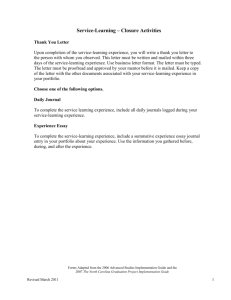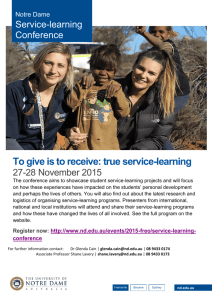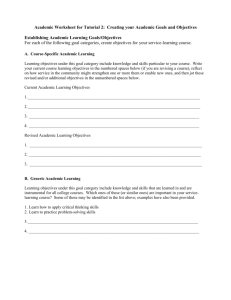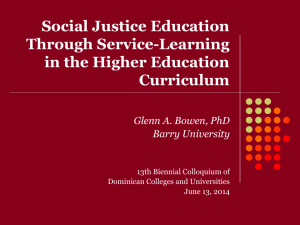Service-Learning - Office of Undergraduate Research & Experiential
advertisement
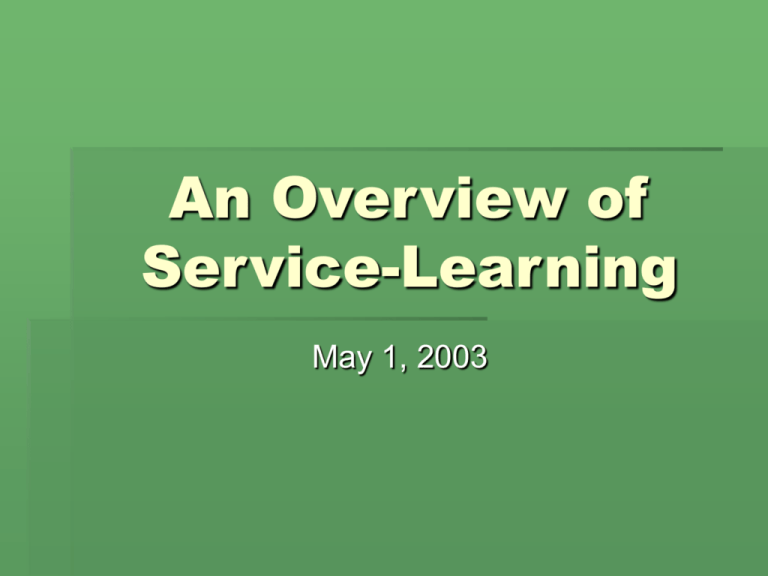
An Overview of Service-Learning May 1, 2003 Presentation Agenda • What is Service-Learning? • History • Distinguishing elements • Examples • Overview of Syllabi • Models in Higher Ed History • 1980’s: National service efforts were launched at the grassroots level, including the Campus Outreach Opportunity League and Campus Compact, which help mobilize service and service-learning programs in higher education. • 1990- 1994: The National & Community Service Act: Congress passed the National and Community Service Act of 1990. The legislation authorizes grants to schools to support servicelearning and demonstration grants for national service programs to youth corps, nonprofits, and colleges and universities. What is Service-Learning? It is a teaching method whereby students learn and develop through active participation in organized service experiences that: • • • • Are integrated into the academic curriculum Meet the needs of a community Provide structured time for reflection Help foster civic responsibility Adapted from the National and Community Service Trust Act, 1993 Program Characteristics • Academic Experience • Links the learning in the classroom to the activity in the community…and vice versa • Reinforces what is learned in the classroom • Designed with clear academic goals Characteristics excerpted from Eyler, Janet and Giles, “Where’s the Learning in Service-Learning?” San Francisco: Jossey-Bass, 1999. • Community Project • Connects the student to the community in activities that are mutually beneficial • Projects take place at the community level • Ideally, students and community leaders participate in planning the project • Reflection Requirement • Built-in opportunities to reflect on the experience • Creates a deeper understanding and better application of subject matter • Increases appreciation of problem and encourages solution analysis • Civic Role and Appreciation • Experiences have a higher purpose that emphasizes the reward and value in service • Increases civic engagement of the University • Gives the student a better understanding of their individual role in society Service-Learning is… • Cleaning up a river bank is just service. • Looking at water samples under a microscope is just learning. • Biology majors meeting state standards by taking samples from local streams, analyzing the samples and then presenting the information to a pollution control agency is service-learning. Service-Learning is NOT… • Community Service • Volunteering These are “Service” • Experiential Learning • Hands-On Learning • Internships These are “Learning” Service Learning Syllabi • Alma College • University of Utah • Notre Dame University Retrieved from Campus Compact (www.compact.org/syllabi) Alma College • Discipline: Environmental Studies, Public Policy, Health • Course: “Comparative Public Health and Environmental Policy” • The course reviews Mexican and US history and government, followed by study of selected health and environmental problems along the US/Mexico border. Students travel to the border to observe conditions and design a project related to environmental-health issues. University of Utah • Discipline: Music • Course: “The Pianist and the Community: Career Development and Volunteerism” • The course emphasizes that community service is a vital aspect of any musical career. Students teach piano to at-risk students and participate in recitals. Notre Dame University • Discipline: Chemistry • Course: “Chemistry in Service of the Community” • Students join with community partners in helping to identify neighborhood homes that have unsafe levels of lead contamination. Six Models for Service-Learning • “Pure” Service-Learning • Intellectual core in the idea of service, not necessarily in a particular discipline • Example: Berea College • As a first-year seminar, students are introduced to the interdisciplinary study of community, focusing on a variety of topics, fostering leadership skills, and introducing them to possible non-profit sector careers and field experience in their majors. Six Models excerpted from Heffernan “Fundamentals of Service-Learning Course Construction,” RI Campus Compact, 2001. • Discipline-Based Service-Learning • Spending a semester in the community with ongoing reflection of their experience • Previous Example: University of Utah • Music course teaches that community service is a vital aspect of any musical career. Activities are based on the music discipline. • Problem-Based Service-Learning • Students serve as “consultants” to the community working on a particular problem or need • Develop solutions to the problem • Assumes a particular knowledge base • Previous Example: Notre Dame University • Chemistry students join with community partners in helping to identify neighborhood homes that have unsafe levels of lead contamination. • Capstone Courses • Designed for a particular discipline • Draws upon knowledge from throughout coursework • Transition from world of theory to world of practice • Example: Portland State University • Senior students participate in an applied research project where they work with the Community Justice Dept. to evaluate the alcohol and drug counseling services. • Service Internships • Intensive experience in a community setting • Regular and ongoing reflective opportunities • Focus on reciprocity – benefit to both student and community • Example: University of Pennsylvania • The Public Service Internship Program is a 12-week summer program that immerses 20 undergraduates in real-world problem solving in the West Philadelphia-Penn community. • Undergraduate CommunityBased Action Research • Popular, independent study option • Students work with faculty to learn research methodology while serving as community advocates • Example: Allegheny College • Creek Connections is a partnership between Allegheny College and regional K-12 schools where AC staff and students provide the framework and assistance for school-based investigative research in local watersheds. Model Programs • University of Pennsylvania • Ranked in top 3 schools for service-learning programs by U.S. News and World Report (2003) www.usnews.com/usnews/edu/college/rankings/brief/acadprogs/acadprogs05_brief.php (retrieved 4/29/03) • University of Maryland • Ranked 24th in U.S. News and World Report for service-learning (2003) www.inform.umd.edu/nowandthen/news/usnewsrankings902.html (retrieved: 4/29/03) • Rutgers University • In 1993, President Clinton publicized the servicelearning program as a model for colleges and universities across the country. University of Pennsylvania • Founded in 1992, the Center for Community Partnerships is Penn's primary vehicle for bringing together knowledge needed to solve the problems so that the University, the city, and society benefit. • Activities • Academically-based community service • Provide technical assistance to faculty • Direct traditional community service • Community Development • Member of Campus Compact • 1200 students participated in one or more of 140 courses; 40-45 courses offered in any one academic year. • Some SL courses exist outside of the Center • Support • Staff: 30 full/part-time staff include University or grant-funded positions and AmeriCorps* VISTA members. • Funding: University support, grant support, and endowment funds. • Governed: Director reports to the Office of the Vice President for Government, Community and Public Affairs and to the Provost. University of Maryland • Founded in 1992, the Community Service Office is housed within the office of Commuter Affairs and Community Service. • Activities • Curriculum-based service-learning • Provide technical assistance to faculty in course development • Co-curricular community service activities • Member of Campus Compact • 1500 students every year enroll in approximately 50 SL courses taught by about 30 faculty members. • About 200 total SL courses offered. • Some colleges require some level of experiential learning, of which SL is a choice • Support • Staff: Four full/part-time staff working with SL • Funding: University support, mini-grants for specific courses • Governed: Director reports to the Vice President of Student Affairs Office. Rutgers University • Citizenship and Service Education (CASE) was formed in 1988 to improve and consolidate the relationship between the University and the broader New Brunswick community. • Activities • Academic-based service learning • Provide technical assistance to faculty in course development • Co-curricular community service programming • Primary resource: In 2000, CASE put a community database resource on the web known as the "Redbook Online". • Faculty use Redbook Online as a search engine to identify suitable placement sites • Community based agencies use it to advertise their organizations to the student community at Rutgers • All SL courses go through CASE. • 500-800 students enroll in almost 50 servicelearning courses each year. • Some departments have SL requirements including the honors program. • Member of Campus Compact • Support • Staff: Two full-time, one part-time, two grad students • Funding: University funds, occasional grant support • Governed: Director reports to the Office of the Vice President of Undergraduate Studies Visit the Programs • University of Pennsylvania • www.upenn.edu/ccp • University of Maryland • www.inform.umd.edu/CSP/serviceLearning.html • Rutgers University • www.case.rutgers.edu



